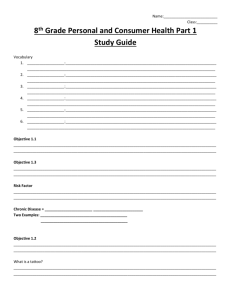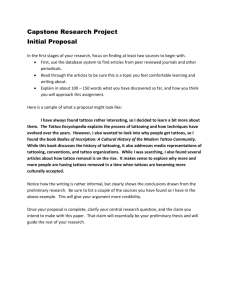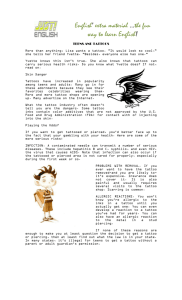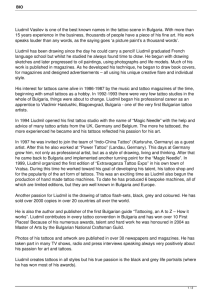TATTOOS AND PERMANENT MAKEUP Marketplace and Chemistry
advertisement
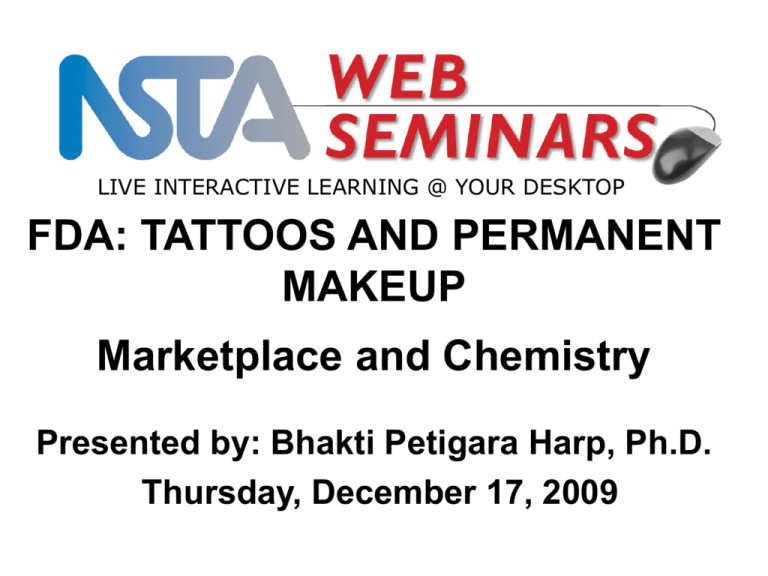
LIVE INTERACTIVE LEARNING @ YOUR DESKTOP FDA: TATTOOS AND PERMANENT MAKEUP Marketplace and Chemistry Presented by: Bhakti Petigara Harp, Ph.D. Thursday, December 17, 2009 1 TATTOOS AND PERMANENT MAKEUP Marketplace and Chemistry Bhakti Petigara Harp, Ph.D. Chemist, Color Technology Team Office of Cosmetics and Colors December 17, 2009 Modules • Regulatory status of tattoo inks and pigments • Marketplace – General body tattoos – Permanent makeup tattoos – Problems with tattoos and permanent makeup • Adverse reactions and FDA responses • Chemistry of tattoo pigments – Inorganic tattoo pigments – Organic tattoo pigments 3 Module 1 • Regulatory status 4 Regulatory Definitions • Color additive – any material capable of imparting color to a food, drug, cosmetic, medical device, or the human body • Types of color additives – organic dyes and pigments, inorganic pigments • Mixture – two or more color additives with or without diluents • Diluent – component of a color additive mixture added to facilitate the use of the mixture in coloring the 5 human body Are tattoo pigments regulated by the FDA? Yes No 6 Regulatory Status of Tattoo Pigments • Color additives must be pre-approved by FDA for use in food, drugs, cosmetics, and medical devices • Approved color additives are listed in the U.S. Code of Federal Regulations – See 21 CFR Parts 73, 74, and 82 • No color additives have been listed for injected use – See 21 CFR 70.5(b) 7 Regulation of Tattoo Inks and Tattoo Pigments in the U.S. • Tattoo inks are cosmetics • Tattoo pigments are color additives requiring pre-market approval • FDA traditionally has not exercised its regulatory authority over tattoo inks or tattoo pigments • The practice of tattooing is regulated by local jurisdictions for sanitation • Recent adverse events have raised FDA’s concern 8 Regulation of Tattooing in Other Countries • E.U. – Tattoos are “non-food products,” not cosmetics – See Opinion of Scientific Committee on Cosmetic Products and Non-Food Products, 17 February 2000 – Pigments and implements are being assessed • Canada – Infection control guidelines – In partnership with provincial and territorial governments – Developed for tattoo practitioners • Australia and New Zealand – Regulation is aimed at infection control – Oversight by individual States and Territories 9 – Legislation does not address irritation, allergy, trauma Let’s Pause Two Minutes for Questions from the Audience 10 Module 2 • Marketplace 11 Marketplace – Definitions • Tattoo ink – a mixture of pigments and diluents intended for introduction into the skin • Pigments – wide variety of inorganic and organic compounds • Diluents – glycerin, propylene glycol, ethanol, witch hazel • Dyes – must be converted to pigments for use in tattoo inks to limit migration 12 Inorganic vs. Organic Tattoo Pigments • Inorganic compounds are easily obtainable from natural sources (e.g., iron oxides) • However, – Iron oxides fade or change color – Historically used mercury and cadmium salts are toxic • Organic pigments first synthesized in mid1800s – Satisfied need for new pigments 13 Advantages of Organic Tattoo Pigments • More intense colors than inorganic pigments • Give wider range of colors • Are removable with laser techniques 14 Marketplace – Inks and implements 15 16 What percentage of people have tattoos? Multiple Choice A. 10% B. 40% C. 90% 17 General Body Tattooing 18 19 20 Fluorescent Tattoo Inks 21 • General body tattoo inks • Tattoo parlors historically avoided the face _______________ __ • Permanent cosmetics inks (face/eyes) 22 Permanent Makeup • Before and after photos (Premier Pigments web site) • Eyeliner • • • • Eyebrows Lipliner Full lips Blusher • Also called micropigmentation 23 Examples of Permanent Makeup EYELINER MOLE EYEBROWS 24 Permanent Makeup Tattoo Machine 25 26 Problems with Tattoos and Permanent Makeup • Safety for skin injection has not been demonstrated • Adverse reactions have occurred • Photosensitivity is a problem • Removal is a problem 27 Problems with Tattoo/Permanent Makeup Industry • Technicians diverse: amateurs to MDs/RNs • Non-medical technicians have little training in sterile techniques • Medical personnel may have limited expertise in makeup application • Beauty salons/tattoo parlors regulated by State and local Health Departments 28 Permanent Makeup in Medical Setting • Injected anesthesia • Clamp secures eyelid • Calipers ensure placement • Varying artistic ability 29 Tattoos/Permanent Makeup in Salon, Home, Workshop Settings • No injected anesthesia • Varying sterile techniques 30 Let’s Pause Two Minutes for Questions from the Audience 31 Module 3 • Adverse Reactions 32 Adverse Reactions to Tattoos and Permanent Makeup • Swelling, cracking, peeling, blistering, scarring • Granulomas (small nodules of inflamed skin) • Keloids (scars that grow beyond normal boundaries) • Serious disfigurement • MRI complications 33 Adverse Reactions – Granulomas 34 Adverse Reactions in Sunlight 35 Adverse Reactions to Surgical Removal • Laser removal – Painful – Expensive – Usually leaves scarring – Iron oxide and titanium dioxide pigments turn black 36 Adverse Reactions to Permanent Makeup • 1988 to 2003 – FDA received only five reports of adverse reactions • 2003 to 2004 – FDA received more than 150 reports of adverse reactions • FDA and CDC – identified 101 patients with adverse reactions • Adverse reactions – tenderness, swelling, itching, and bumps • Clinical diagnoses – allergic or granulomatous reactions 37 Adverse Reactions to Permanent Makeup 38 FDA and CDC Actions • July 2 2004 – FDA alerted public to concerns with Premier Pigment brand of ink shades – “FDA Talk Paper” (press release) – Web site (archived) • Sept 27 2004 – Product line recalled by manufacturer • July 2005 – Case study in Archives of Dermatology • June 28 2007 – Letter to New England Journal of Medicine • Current web site “Tattoos and Permanent Makeup” http://vm.cfsan.fda.gov/~dms/cos-204.html 39 Adverse Reactions to Tattoo Inks Without Preservatives • “The ingredients of “… “ UV Tattoo Inks: (PMMA) Polymethylmethacrylate 97.5% and microspheres of fluorescent dye 2.5% suspended in UV sterilized, distilled water with no preservatives or other additives.” • “TATTOOISTS REMEMBER - these black light tattoo inks are made with sterilized distilled waters, do not add foreign objects into your ink bottles!. This is not an alcohol based tattoo ink.” 40 FDA Action – Starbrite Ink Contamination • (2004) Belgium withdrew “Starbrite Colors” tattoo ink from market because of microbial contamination • FDA analyses found bacteria (Pseudomonas aeruginosa) and mold (Acremonium) • Resulted in manufacturer recall of Starbrite ink (Class II, reversible injury) • Starbrite ink became contaminated because the manufacturer removed alcohol preservative from their 41 ink formula DEPARTMENT OF HEALTH & HUMAN SERVICES Food and Drug Administration New England District One Montvale Avenue Stoneham, Massachusetts 02180 (781) 596-7700 FAX: (781) 596-7896 March 15, 2005 Meredith Nicholson President Papillon Supply and Manufacturing 118 Pearl Street Enfield, Connecticut 06082 Recall Number: F-213-5 Dear Ms. Nicholson: The U.S. Food and Drug Administration agrees with your decision to recall the Starbrite brand Black Magic Color , packaged in individual ½ oz., 1 oz., 2 oz., 4 oz. and 8 oz. size translucent plastic, codes 7996988, 7996989. We consider the product to be adulterated as it is contaminated with Acremonium mold and Pseudomonas aeruginosa. We have reviewed your action and conclude that it meets the formal definition of a firm initiated recall. This is significant, as your action is an alternative to a Food and Drug Administration (FDA) legal action to remove your product from the market. The recall will be reported in an issue of the FDA Weekly Enforcement Report. The recall has been classified as a Class II recall. A Class II recall is defined as a situation in which the use of, or exposure to, a violative product may cause temporary or medically reversible adverse health consequences or where the probability of serious adverse health consequences is remote. Our evaluation indicates the “Depth of Recall” should be conducted to the direct account level. Level A effectiveness checks have been assigned to your recall. Effectiveness checks are actions taken by your firm to verify that consignees at user level have received notification and have taken appropriate action. Level C effectiveness requires that your firm conduct effectiveness checks on 10% of all direct accounts contacted. We request that you submit monthly status reports until your recall is completed. The status reports should contain the information outlined in Section 7.53(b)(1-6) of the Recall Enforcement Policy. 42 Problems with Tattoo Ink: Claiming FDA Approval on Web Sites • Polymethylmethacrylate in tattoo inks: “We researched scientific articles on bone repair, plastic surgery, orthodontics, body modification, and other medical uses of polymethylmethacrylate (PMMA). The PMMA is what makes this ink absolutely safe, and gives this ink its FDA Approval.” • On “Chameleon Body Art Supply” web site: http://www.crazychameleonbodyartsupply.com/bmx1000-chameleon-tattoo-inks.htm 43 Problems with Tattoo Ink: Citing FDA Approval for Tattooing Fish • FDA letter dated April 3, 1995: “Having reviewed the information supplied by you [our manufacturer of the ink] and your supplier ... FDA would have no objection to the use of your photonic dye marking [tattooing] system ...” • On “Captain Jack’s Tattoo Studio” web site: http://www.captainjackstattoo.com/content/blacklig ht-inks 44 Temporary Tattoos – Decals • Temporary tattoos are regulated as cosmetics • Declaration of ingredients is required • Approved color additives are required • Import alert – for temporary tattoos containing non-permitted (illegal) color additives • http://www.fda.gov/Cosmetics/ProductandIngredi entSafety/ProductInformation/ucm108569.htm 45 Body Decoration with Henna 46 Is henna approved for use on the skin? Yes No 47 Henna Tattoos and Body Decoration (Mehndi) • Henna is derived from the leaves of the shrub Lawsonia inermis – Brown, orange-brown, or reddish-brown tints • Approved color additive for coloring hair – See 21 CFR 73.2190 • Coloring the skin is an unapproved use of the color additive 48 • Import alert – for “Henna based skin color” products Body Decoration with Black Henna 49 Adverse Reactions to Black Henna • “Black henna” contains additional coloring ingredients – Allows darker, more intense color – Speeds up tattooing process, makes tattoo last longer • p-Phenylenediamine (PPD) may be added – A hair dye – Not approved for direct application to the skin • Allergic reactions to PPD – Potent skin sensitizer, possibly for lifetime – Allergic contact dermatitis – Cross-reactions to PABA, benzocaine, indigo 50 • Feb 13 2007 Article in Canadian Medical Assn Journal Let’s Pause Two Minutes for Questions from the Audience 51 Module 4 • Chemistry of Tattoo Pigments 52 Chemistry of Tattoo Pigments • Basic concept of color • Inorganic pigments • Organic pigments – Insoluble organic compounds – Dyes converted to insoluble pigments • None are FDA approved for use in injections (tattoos) 53 Why not use FD&C colors in tattoos? Type in the chat 54 Electromagnetic spectrum www.owlnet.rice.edu/~psyc351/Images/Electroma 55 Basic Concepts of Color • Interaction of visible light with a compound – Wavelengths of light – Types of atoms in the compound • Dye molecules contain electrons at many energy levels – Some of the electrons can absorb visible light – These electrons undergo transitions from lower to higher energy levels • Absorption removes some visible light – We see the complementary color 56 Production of complementary colors Absorption bands • 400-430 nm (violet) • 430-480 nm (blue) orange • 480-550 nm (green) • 550-600 nm (yellow) • 600-700 nm (red) see yellow see see red see violet see blue 25.722 Peak 10 25.198 Peak 20 630.2 236.9 493.8 306.6 316.1 406.8 719.5 790.5 660.7 300.00 400.00 500.00 nm D&C Red No. 6 600.00 700.00 200.00 300.00 400.00 500.00 600.00 700.00 800.00 nm FD&C Blue No. 1 57 What color would you see? Absorptions bands: • 400-430 nm (violet) • 430-480 nm (blue) • 480-550 nm (green) • 550-600 nm (yellow) • 600-700 nm (red) see yellow see orange see red see violet see blue 25.722 Peak 10 630.2 306.6 406.8 719.5 790.5 200.00 300.00 400.00 500.00 600.00 700.00 Multiple Choice A. Red B. Yellow C. Blue 800.00 nm 58 Absorptivity value • Measure of dye’s ability to absorb light • High absorptivity value: more efficient, more economical – Dye absorbs a large amount of energy so you only need a small amount in the product • Low absorptivity value: not as efficient, less economical – Dye absorbs less energy so more is needed in the product 1.00 1.08 629.56 1.0 0.9 0.9 0.8 0.8 0.7 0.7 0.6 0.6 A A 0.5 0.5 0.4 0.4 0.3 0.3 0.2 644.94 0.2 408.42 0.1 0.1 0.00 0.00 400.0 400.0 500 600 NM 700 750.0 FD&C Blue No. 1, α = 0.16 500 600 nm 700 750.0 59 D&C Green No. 5, α = 0.02 Early food and cosmetic uses of dyes and pigments • Foods colored with spices and minerals – Paprika, turmeric, saffron, iron oxides – Wine artificially colored in 300 B.C. • Cosmetics from vegetable and mineral sources – White lead – Kohl (contains lead or antimony) – Copper ore for eye shadow – Vegetable extracts for the skin • Tattooing – Charcoal, inorganic pigments 60 Historically Used Tattoo Pigments • Black – iron oxide, carbon • Red – mercury sulfide, iron oxide • Yellow – cadmium sulfide, iron oxide • Blue – cobaltous aluminate, ferric ferrocyanide • Green – chromium oxide, chromium hydroxide • White – titanium dioxide 61 Historically Used Minerals in Tattoo Pigments • Black – Magnetite (FeO•Fe2O3) – Charcoal (C) • Red – Hematite (Fe2O3) – Cinnabar (HgS) • Yellow – Limonite (FeO•OH•nH2O) • White – Corundum (Al2O3) – Rutile (TiO2) – Zincite (ZnO) 62 FDA Analyses of Inorganic Pigments in Tattoo/Permanent Makeup Inks • Samples of sixty-three tattoo/permanent makeup inks from three different manufacturers • Analyzed by x-ray fluorescence spectrometry • Results found Ti, Al, and Fe to be most common • Historically reported Hg, Cd, Co, and Ni were not found 63 Inorganic Elements Found in Tattoo Pigments • • • • • • • • • Black – Fe Gray – Fe, Ti, Al Brown – Fe, Ti, Al, Ca Blue – Ti, Al, Cu Green – Fe, Ti, Al, Ba, Br, Cr, Cu Red and Magenta – Ti, Al, Fe Orange – Ti, Fe, Al Yellow – Ti, Fe, Al White – Ti, Al 64 FDA Analyses of Organic Pigments in Tattoo/Permanent Makeup Inks • Samples of thirty-five tattoo/permanent makeup inks analyzed from four different manufacturers • Compounds in inks extracted and separated by HPLC • Organic pigments identified by comparison of UVvisible spectra and HPLC retention times with reference standards • Results showed mixtures of organic pigments from 65 different chemical classes Organic Pigments in Tattoo/Permanent Makeup Inks Chemical Class Sample 1 2 3 4 5 6 7 8 9 10 11 12 13 14 15 16 17 18 19 20 21 22 23 24 25 26 27 28 29 30 31 32 33 34 35 Benzimidazolones Pigment Brown 25 x Pigment Orange 36 x x x x x x x x x x x x Monoazo Naphthol Pigment Orange 62 Pigment Red 170 Pigment Red 22 Quinacridone Pigment Red 122 Monoazo Arylide Pigment Yellow 74 x x x x x x x x x x x x x x x x x x x x x x x x x x x x x x **Other unidentified peaks were found x x x x x x x 66 Organic Tattoo Pigments – Dye Structures • Anthraquinone • Phthalocyanine • Indigoid • Azo, Disazo • Benzimidazolone • Quinacridon e 67 C.I. Pigment Red 83 • • • • • C.I. 58000 CAS No. 72-48-0 Alizarin Red Anthraquinone dye 1,2-Dihydroxy-9,10anthracenedione 68 C.I. Pigment Red 170 • • • • • C.I. 12475 CAS No. 2786-76-7 Fast Red F5RK Monoazo dye 4-((4-(Aminocarbonyl) phenyl)azo)-N-(2ethoxyphenyl)-3-hydroxy2naphthalenecarboxamide 69 C.I. Pigment Orange 16 • C.I. 21160 • CAS No. 6505-28-8 • Dianisidine Orange or Benzidine Orange R • Disazo dye • 2,2'-((3,3'-dimethoxy (1,1'-biphenyl)-4,4'diyl)bis(azo))bis(3-oxo-Nphenyl-butanamide) 70 C.I. Pigment Yellow 151 • • • • C.I. 13980 CAS No. 31837-42-0 Fast Yellow H4G Benzimidazolone and monoazo dye • 2-[[1-[[(2,3-Dihydro-2oxo-1H-benzimidazol-5yl) amino]carbonyl]-2oxopropyl]azo]benzoic acid 71 C.I. Pigment Violet 32 • • • • C.I. 12517 CAS No. 12225-08-0 Brillfast Vivid Magenta Benzimidazolone and monoazo dye • N-(2,3-dihydro-2-oxo-1Hbenzimidazol-5-yl)-4[[2,5-dimethoxy-4[((methylamino)-sulfonyl]phenyl]-azo]-3-hydroxy-2naphthalenecarboxamide 72 C.I. Pigment Blue 66 • • • • • • C.I. 73000 C.I. Vat Blue 1 CAS No. 482-89-3 Indigo Indigoid dye 2-(1,3-Dihydro-3-oxo-2Hindol-2-ylidene)-1,2dihydro-3H-indol-3-one 73 C.I. Pigment Blue 15 • • • • C.I. 74160 CAS No. 147-14-8 Copper phthalocyanine Cyan Blue GTNF or Heliogen Blue 7044T • Phthalocyanine dye • Copper, (29H,31Hphthalocyaninato(2-)N29,N30,N31,N32)74 C.I. Pigment Red 122 • C.I. 73915 • CAS No. 980-26-7 • Acramin Scarlet LDCN or Fastogen Super Magenta R • Quinacridone dye • 5,12-Dihydro-2,9dimethylquino(2,3b)acridine-7,14-dione 75 Tattoo Pigment Photodecomposition Studies • FDA’s National Center for Toxicological Research (NCTR) • Cui, Y., Spann, A. P., Couch, L. H., Gopee, N. V., Evans, F. E., Churchwell, M. I., Williams, L. D., Doerge, D. R., and Howard, P.C., “Photodecomposition of Pigment Yellow 74, a Pigment Used in Tattoo Inks, Photochemistry and Photobiology, vol. 80, pp. 175 -184, 2004 76 Photodecomposition of Pigment Yellow 74 in simulated solar light O CH3 O CH3 H3C NH O NH N O O N O O O CH3 CH3 H3C HO O NH N NH2 O CH3 H3C O O O N NH O O 77 Photodecomposition of Pigment Red 22 in 532 nm Nd:YAG laser light O CH3 HO O NH N N N O O CH3 HO NH O N NH2 CH3 O O N O 78 Tattoo Pigments and Color Additives Indigo (tattoo pigment) and 21 CFR 74.3106 drugs, D&C Blue No. 6 sutures, (for use in sutures only) cement) 21 CFR 74.101 FD&C Blue No. 2 (for use in food, cosmetics, and bone 79 Tattoo Pigments and Color Additives • C.I. Pigment Blue 15 • Copper phthalocyanine • 21 CFR 74. 3045 [Phthalocyaninato(2-)] copper (for use in sutures only) 80 Tattoo Pigments and Color Additives • Aluminum oxide – 21 CFR 73.1010 • Carmine – 21 CFR 73.100 – 21 CFR 73.1100 • Iron oxides – 21 CFR 73.2250 – 21 CFR 73.3125 • Manganese violet – 21 CFR 73.2775 • Mica – 21 CFR 73.1496 – 21 CFR 73.2496 • Titanium dioxide – 21 CFR 73.575 – 21 CFR 73.1575 – 21 CFR 73.2575 – 21 CFR 73.3126 • Ultramarines – 21 CFR 73.50 – 21 CFR 73.2725 • Zinc oxide – 21 CFR 73.1991 – 21 CFR 73.2991 • Luminescent zinc oxide – 21 CFR 73.2995 81 Conclusions • Marketplace – Wide variety of inorganic and organic pigments and diluents in tattoos and permanent makeup • Adverse reactions – and FDA responses • Chemistry – Some tattoo pigments have been shown to photodecompose – C.I. Pigment Yellow 74 – C.I. Pigment Red 22 • Misleading web sites!!! No pigments have been approved by FDA for tattooing humans 82 Thank you to the sponsor of tonight's Web Seminar: http://learningcenter.nsta.org 84 http://www.elluminate.com 85 National Science Teachers Association Dr. Francis Q. Eberle, Executive Director Zipporah Miller, Associate Executive Director Conferences and Programs Al Byers, Assistant Executive Director e-Learning NSTA Web Seminars Paul Tingler, Director Jeff Layman, Technical Coordinator LIVE INTERACTIVE LEARNING @ YOUR DESKTOP 86
